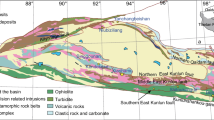Abstract
To decipher the geodynamic significance of Cenozoic magmatism along the Red River shear belt, geochemical analyses, U-Pb and Rb-Sr dating, and Pb-Sr-Nd isotope tracing were undertaken. Zircon, monazite, titanite, and a Ti-U-oxide from foliated granitoid intrusions in the shear belt gneisses yield U-Pb emplacement ages of 33.1 ± 0.2 (2σ), 31.9 ± 0.3, 25.8 ± 0.2 and 24.7 ± 0.2 Ma, and an age of 35.0 ± 0.3 Ma was obtained for the roughly 100 km long, adjacent Jinping (Phan Si Pang) alkali granite. Together with our previous data the new ages suggest that magmatism and left-lateral strike-slip movements occurred coevally during latest Eocene–Oligocene times from 33 to 22 Ma. The Rb-Sr dating of muscovite and biotite from the northernmost gneisses indicates that cooling to 500 °C occurred at 52.6 ± 1.1 Ma, pre-dating the onset of magmatism, whereas further cooling to 300 °C took place at 28.9 ± 0.6. This shows that unroofing in the north took place almost 9 million years earlier than in the central gneiss segments of the shear zone. Geochemical data substantiate two types of magmas: (1) amphibole-bearing intrusions of alkaline trend which are derived from sources with Isr: 0.7065–0.7089 and i Nd: −3.7 to −6.6; (2) leucogranitic layers and bodies having Isr: 0.7084–0.7354 and i Nd: −3.3 to −13.4. The former type of intrusion is found in both the gneisses and the adjacent unmetamorphosed cover rocks, whereas leucogranites are restricted to the shear belt gneisses. Source signatures of the alkaline intrusions lie adjacent to the those of OIB, plotting at the lower end of the Mantle Array. Contamination of these melts by continental material seems to be very limited. On the other hand, the leucogranitic layers are essentially crustal derived but none of the them has country rock isotope signatures, requiring melting of crust different from the actually exposed gneisses. Magma sources similar to those of ocean island basalt indicate magmatism to involve melting of light rare earth element and large ion lithophile element enriched mantle domains, most likely present in the lithosphere underneath the region. Since lithospheric thickening or subduction can be ruled out to produce both types of magmas, the presence of an important thermal anomaly is required, which is coevally active with left-lateral strike-slip shear. Adiabatic decompression and melting within the rising anomaly is the most plausible mechanism to produce the mantle magmas, which successively migrate through the crust to induce anatectic melting at 20–15 km crustal depth. Alkaline magmas largely dominate the volume of magmatism along the belt, being continuously present in the shear zone for millions of years. Such lubrication potentially explains how very large amounts of displacement can be absorbed in surprisingly narrow shear zones such as the Red River belt, possibly also playing a rôle for where and when zones of plate-scale lateral extrusion develop.
Similar content being viewed by others
Author information
Authors and Affiliations
Additional information
Received: 2 June 1998 / Accepted: 24 September 1998
Rights and permissions
About this article
Cite this article
Zhang, LS., Schärer, U. Age and origin of magmatism along the Cenozoic Red River shear belt, China. Contrib Mineral Petrol 134, 67–85 (1999). https://doi.org/10.1007/s004100050469
Issue Date:
DOI: https://doi.org/10.1007/s004100050469




